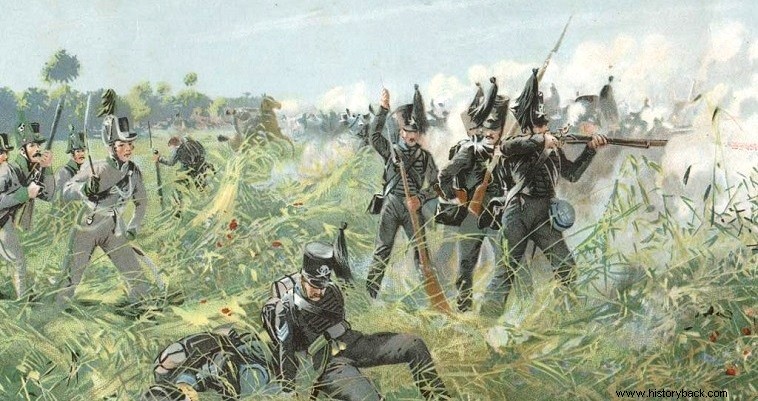
Learning of the Prussian defeat at Lini, the British Commander-in-Chief the Duke of Wellington decided to retreat to a previously unknown location at Waterloo to a position which offered him defensive advantages and which he had previously identified as an alternative in case of need . On June 17, Wellington's multinational army deployed on St. John's Hill, awaiting the French.
The Black Brigade of the Germans of the State of Braunschweig led after the death of Duke Friedrich Wilhelm by Colonel Olfermann numbered 5,962 men – 4,586 infantry, 866 cavalry and 510 gunners with 16 guns. However, the Brigade was not supposed to act concentrated in the world-historical battle, but divided into three sections.
The Hussars and Uhlans were detached from the Brigade and joined the British 7th Cavalry Brigade. The Vanguard Battalion (rockers), the Corps Battalion and the 1st Light Infantry Battalion were deployed at the north-west end of Ougamon Field in support of the British. The 2nd and 3rd Light Infantry Battalions and the three line battalions, together with the artillery, were initially placed in a second echelon, as a reserve.
The garrison of Ougamon was the British 2nd Guards Brigade under Major General Byng. The Battle of Waterloo began at 11.30 in the morning as Napoleon waited for the ground to dry as much as possible after the evening downpour. Opposite Ougamont was deployed the French 2nd Army Corps (SS) of General Reig with the 5th, 6th, 7th and 9th MP and the 2nd Light Cavalry Division.
The French attack on Ouagamont began with a heavy bombardment. Nevertheless, for three whole hours, the French attacks were repulsed. Until then the Braunschweigers had not been seriously involved in the battle. On the allied left, the attack of the French was repelled even with the sacrifice of the famous 2nd Brigade (Union Brigade) of the British cavalry.
The French continued to launch new attacks on the Allied center and right focusing on the Allied strongholds of La Haye Side and Ouagamont. Unable to break the Allied lines, the French marshal Ney gathered Milo's Cuirassier Division (24 iles) and Guards Light Cavalry Division (19 iles) and unleashed them on the Allies.
The British battalions formed squares. The British commanders were worried about the Braunschweigers and their performance, but theGermans calmly also formed squares and received the French cavalry with heavy fire. The French cavalry was repulsed and retreated pursued by the allies, among them the Hussars and Uhlans of Braunschweig.
After the first failure Ney did not get discouraged but continued the attacks. But again waves of French cavalry broke into the allied squares and the defeated French horsemen were pursued. At the same time, however, La Haye was overrun as the heroic garrison ran out of ammunition. At the same time the three Braunschweiger battalions fighting there were reinforced by a British mounted artillery which supported them very satisfactorily. The French, however, launched new mass attacks which were repelled by the heroic defense of the allied infantry.
At the same time the first Prussian divisions began to arrive on the French right. However it was clear that Wellington would have to meet with his own, hard-tested men, the final French assault before the arrival of the Prussians decided the outcome. In view of the expected attack, Wellington rearranged his forces and threw his reserves into the battle. The Braunschweiger battalions in reserve filled the gap between two British infantry brigades and a British and Nassau brigade.
Having no other reserves, Napoleon decided to throw the Guard into battle. French pressure initially forced the men from Nassau and Braunschweig to retreat about 100 meters. At the critical moment Wellington appeared and, encouraging the Braunschweigers, ordered them to hold on by all means, which they did, despite the lack of ammunition they were facing. The Germans kept the bayonets.
After all, in a short time the crisis had passed. The bulk of Blycher's Prussian army had appeared on the battlefield and was pressing the French. Wellington then decided it was time to strike back. The allied army did attack with yachts against the French.
The Battle of Waterloo had ended in victory for the Allies. But the price was heavy. The Braunschweigers suffered losses of about 660 men. The day after the battle, the Braunschweigers had the honor of escorting around 2,000 French prisoners to Brussels. Then they marched to Paris. They returned home on December 6, 1815 victorious.
